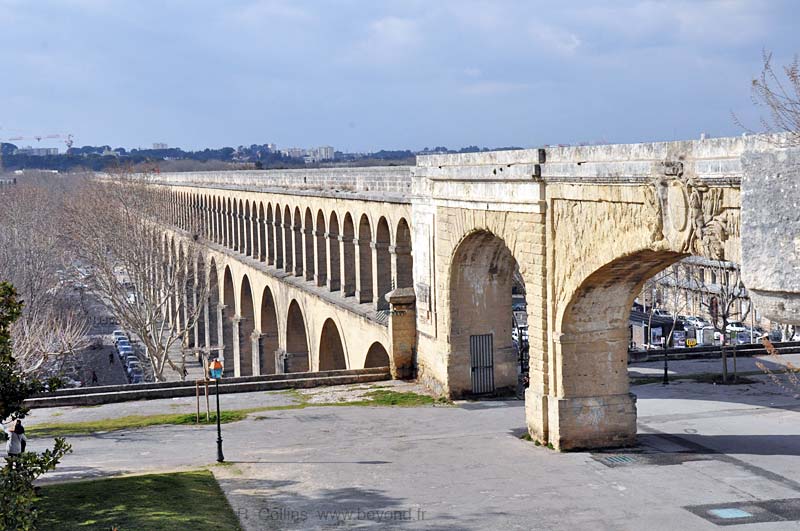Montpellier
• Hérault (34000) • Population: 264,538 • Altitude: 27 m
Gallery of 14 photos for Montpellier
Montpellier is a very dynamic town in the South of France, the capital of the Languedoc-Roussillon region and a university town. Montpellier is one of the rare southern French towns without a Greek or Gallo-Roman heritage. It does have a strong Medieval history, and some wonderful 19th-century archetcture.
 Montpellier is a town with great shopping and dining, lots of terrace cafés, pretty squares and some great trompe-l'oeil wall paintings.
Montpellier is a town with great shopping and dining, lots of terrace cafés, pretty squares and some great trompe-l'oeil wall paintings.
The most central square is probably Place Martyrs de la Résistance, in the heart of town, with picturesque streets radiating off in all directions and surrounded by shops and restaurants.
From here the Rue Foch goes due west to the Arch de Triomphe and out to the Promenade du Peyrou park.
 Place St Roch is another nice square, in the heart of the old town, south of Place de la Résistance. The square is named after its resident church, the 19th-century Neo-Gothic Eglise Saint-Roch.
Place St Roch is another nice square, in the heart of the old town, south of Place de la Résistance. The square is named after its resident church, the 19th-century Neo-Gothic Eglise Saint-Roch.
Promenade du Peyrou
 Montpelllier's Promenade du Peyrou is 3-hectare esplanade at the western side of the town center. It was built in 1689 just outside the town walls, at the entry with the Arc de Triomphe.
Montpelllier's Promenade du Peyrou is 3-hectare esplanade at the western side of the town center. It was built in 1689 just outside the town walls, at the entry with the Arc de Triomphe.
 At the western end of the esplanade is the 18th-century monumental water tower (chateau d'eau monumental), a tall, white structure with columns, overlooking a basin. This chateau d'eau was built in 1768 by Henri Pitot (inventor of the famous "pitot tube") to distribute drinking water to the town.
At the western end of the esplanade is the 18th-century monumental water tower (chateau d'eau monumental), a tall, white structure with columns, overlooking a basin. This chateau d'eau was built in 1768 by Henri Pitot (inventor of the famous "pitot tube") to distribute drinking water to the town.
The source of the drinking water comes from St Clément via a 14-km long aqueduct, entering
the Promenade du Peyrou and the chateau d'eau over this double-arched section.
Favorite Sons
Vincent Van Gogh and Paul Gauguin visited Montpellier together in December, 1888 and visited the Musée Fabre.
History of Montpellier
Name
First record, 985, probably about the time the original castle and walls were built.
Medieval: Montpellier was founded under the Guilhem dynasty, a local feudal lord who combined two hamlets and built a castle inside fortified walls. The earlier coastal settlement of Maguelone had been located 10 km south, but needed to be moved inland because of pirate rades.
The medieval town walls that are still visible today were around the year 1200. Two of the early-13th-century towers, the Tour des Pins and the Tour de la Babotte still remain.
Montpellier became a prominent Mediterranean trading center in the 12th century. In 1180, Willian VIII of Montpellier gave freedom for people of all religions to teach medicine in Montpellier; Muslims, Jews, Cathars and (later) Protestants lived together in a richly diverse cultural life.
Cardinal Conrad of Urach, legate of Pope Honorius III, established the faculties of law and medicine 1220. Montpellier has been prominent since that time as a European center for medical schools.
In 1204 the Kings of Aragon were given Montpellier and its dependencies as part of the dowery when Marie of Montpellier married Peter II of Aragon. Under the Kings of Aragon, Montpellier became an important economic center and the primary center for the spice trade in the Kingdom of France.
Montpellier was the second or third most important city of France in the 12th and 13th centuries, with around 40 000 inhabitants before the Black Death.
Montpellier passed from the Kings of Aragon to James III of Majorca, who sold the city to the French King Philip VI in 1349.
During the 14th century, Pope Urban VIII built a new monastery dedicated to Saint Peter. Montpellier eventually gained a bishop, who moved from Maguelone in 1536, and the huge monastery chapel became a cathedral.
In 1432, Jacques Coeur established himself in Montpellier in 1432. He was one of the founders of trade between France and the Levant, and the city became an important economic center. Around 1481, Marseille overshadowed Montpellier as a trading site.



